Trujillo, Peru’s City of Eternal Spring
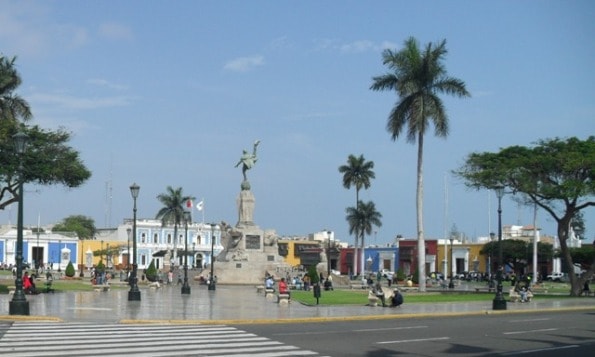
The Plaza de Armas in Trujillo, Peru (photo © Tony Dunnell)
Colonial elegance and Moche temples. The marinera, the paso horse and the ghosts of the Chimú culture. Head north, my friends, head north, up the coast from Lima to Peru’s City of Eternal Spring…
Excuse the slightly romantic intro, but Trujillo really is that kind of city. And it’s not just the historic city center that sets Trujillo apart; once you’ve explored the cathedrals, the republican mansions and the fine, fine eateries, head a short distance beyond the city limits where lie the remnants of more ancient civilizations.
A Brief History of Trujillo, Peru
Back in the day, when the Incas were a tiny tribe and the Spaniards were yet a distant nightmare, the Moche (Mochica) civilization dominated the coast of northern Peru. Based in the area now occupied by the administrative region of La Libertad and its capital city of Trujillo, the burgeoning Moche culture, which existed from about 100 AD to 800 AD, built massive structures such as the Huaca del Sol and the Huaca de la Luna. As capable as it was, the Moche civilization collapsed, possibly due to environmental change.
From the fall of the Moche rose the fledgling Chimú culture, a civilization that would grow to become a dominant state (the Kingdom of Chimor) along the coast of Peru. The Chimu Kingdom expanded from its vast capital city of Chan Chan (near present-day Trujillo), remaining a powerful regional force before falling to the now potent Inca Empire in about 1470 (not long before the arrival of the Spanish).
With the Chimu Kingdom spent and the region subject to the Incas, the sands along the north coast of Peru now felt the weight of Spanish boots and heavy hooves. To take hold of the region, the Spanish conquistador Diego de Almagro founded the settlement of Trujillo de Nueva Castilla on December 6, 1534, becoming one of the first conquistador settlements in South America. Just five years after its foundation, Trujillo had developed a thriving economy centered on sugar cane and wheat production.
Trujillo was almost destroyed by an earthquake in 1619, a disaster that only served to strengthen the religious nature of the settlement. The city attracted various religious orders, which in turn lead to a boom in church construction.

Old plan of the city of Trujillo showing the elliptical defensive wall (first published in 1789)
Due to its proximity to the coast, Trujillo became a target for pirates and privateers, a threat that prompted the construction of the Wall of Trujillo. Upon its completion in 1689, the elliptical defensive wall encircled the entire urban center. The wall was later destroyed to allow for city expansion; only fragments remain today, but the elliptical Avenida España — which encircles the historic center — makes it easy to spot the former location of the wall.
The 17th and 18th centuries were marked by droughts, flooding and earthquakes, but the city pulled through to play a pivotal role in Peru’s fight for independence. The city declared its independence on December 29, 1820, a full six months before Peru declared its independence from Spanish rule.

The Modern City of Trujillo, Peru
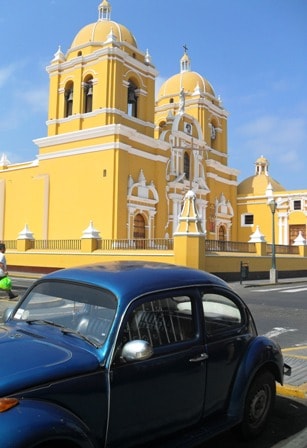
Trujillo Cathedral in Peru (photo © Tony Dunnell)
Trujillo is the third largest city in Peru after Lima and Arequipa, with a population of 682,834 (National Census 2007). It also has a reputation for being one of the most dangerous cities in Peru, but you certainly shouldn’t avoid Trujillo because of it. As with any other big city, stay aware of your surroundings, especially at night, and exercise basic security measures.
On a more positive note, Trujillo is one of the most elegant colonial cities in Peru. The historic center — the area located within Avenida España (the location of the old city wall) — is packed with colonial casonas and republican-era mansions. It’s an impressive sight, especially the beautiful Plaza de Armas (main square) with its central monument and surrounding historic buildings.
It’s easy to spend hours strolling through the historic streets taking in the sights and sounds of the old city — a good thing for budget backpackers in the otherwise expensive colonial core. And when you’ve had your fill of Spanish colonialism, jump on a bus (or arrange a tour) and head back in time to the surrounding Moche and Chimú archaeological sites.
Tourist Attractions in Trujillo
If you really want to get to grips with Trujillo and take in most of the main attractions, you’ll ideally need at least three full days. All of the main tourist attractions (apart from the historic center itself) lie outside the city, but there are still plenty of things to do in the urban area.
If you’re a fan of churches, welcome to paradise. Trujillo’s cathedral dominates one side of the Plaza de Armas, while other religious buildings — such as the Iglesia del Carmen and Iglesia de la Merced — are scattered throughout the surrounding streets (throw a stone and you’ll probably hit one — theoretically, of course, don’t get yourself arrested).
If churches aren’t your thing, you might enjoy snooping through Trujillo’s colonial- and republican-era casonas. These mansions represent how the other half lived back when cannons and campaigns were all the rage; try the Palacio Iturregui (Pizarro 688), the Casona Orbegoso (Orbegoso 553) and the Casa Ganoza Chopitea (Independencia 630). Opening hours vary.
As for museums, Trujillo and La Libertad certainly can’t compete with Chiclayo and the Lambayeque Region further north (home to some of Peru’s best museums such as the Brüning Museum and the Tumbas Reales de Sípan). What the city does have, however, is a good Archaeology Museum (Junín 682), the charming Museo del Juguete (Toy Museum; Independencia 705) and the quite frankly disturbing Zoological Museum (San Martín 368).
In terms of festivals and events, keep an eye out for free marinera dance performances and paso horse displays on the Plaza de Armas (some Sundays). There’s also a major marinera festival in January and the annual Festival Internacional de la Primavera (Spring Festival) in late September and early October.
For more tourist info and maps etc, visit the iPerú office on the Plaza de Armas.
Archaeological Sites Near Trujillo
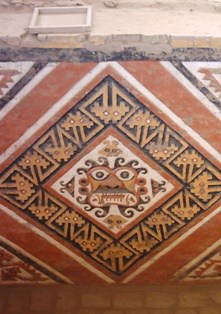
Mural on the walls of the Huaca de la Luna (photo © Tony Dunnell)
There’s an impressive array of archaeological sites within easy reach of Trujillo, either by public transport or with a tour agency.
Don’t miss the fantastic Huacas del Sol y de la Luna complex; the Huaca de la Luna pyramid is one of my favorite archaeological sites in the whole of Peru. You don’t need a tour agency for this trip, just hop on a combi destined for the site (departure points can change, so ask a local to point you in the right direction). You can pick up a guide when you arrive.
The Chimú capital of Chan Chan is also an easy day trip (or half-day) from Trujillo. The site is vast but not as well preserved as the Huaca de la Luna; the well-defined walled areas (primarily the Tschudi complex) are the result of extensive restoration. Again, no tour agency needed; hop on a combi and find a guide at the site.
Other sites include the Huaca Arco Iris (or Huaca del Dragón), Huaca Esmerelda and the more distant Huaca el Brujo archaeological complex (about 37 miles / 60 km from Trujillo).
Where to Stay in Trujillo
If you want to stay in the historic center of Trujillo, expect to pay a sizeable amount for a room. There are some budget accommodation options, but they suck. Seriously, what’s up with Trujillo’s hostels?
For me, one hotel stands out from the crowd in terms of value for money. Just a block and a half from the Plaza de Armas is the Hotel Colonial (Independencia 618), a tried and tested midrange option that’s hard to beat. With single rooms from S/.50 to S/.60 (US$18 to $22) and matrimonial rooms for S/.90 ($33), the Colonial is perhaps a little above most shoestringer budgets but it’s definitely worth it.
A slightly more expensive option not far from the Hotel Colonial is La Hacienda (San Martín 780), a relative newcomer on the scene with rooms starting at around S/.120. It’s a mix of colonial and modern in a restored building, with plenty of details to make you feel right at home. Oh, and there’s a sauna included in the price.
Eating in Trujillo
Trujillo is a great place for culinary travelers, with plenty of tasty regional dishes featuring fresh ingredients from both land and sea. As you’d expect from a major coastal city, the seafood is excellent and the ceviche plentiful. Trujillo also has traditional plates such as cabrito (goat), shambar (a classic trujillano soup) and pato guisado (stewed duck).
Prices in the historic center can be high, but affordable options are not too hard to find. For hearty regional dishes in a small but historic setting, try El Rincon de Vallejo (Orbegoso 303). For regional food and excellent ceviche, head to the family-friendly and informal Sal y Pimienta (Colón 201). If you want to try some local plates without blowing the budget, try La Casona (San Martín 677); for hunks of pork and reasonably-priced beer (a rarity in the city center), pull up a seat in Los Luise’s (two locations in close proximity behind the market, Bolivar 526 and San Agustín 120).
Finally, two places outside the historic center are well worth a visit. Don Rulo Cebicheria (Las Gemas 181, Santa Ines) is perhaps my favorite restaurant in Trujillo, serving fresh and mountainous platefuls of seafood as well as non-fishy options. For pure unadulterated meat, try El Cuatrero Parrillada (Francisco Borja 187, La Merced).
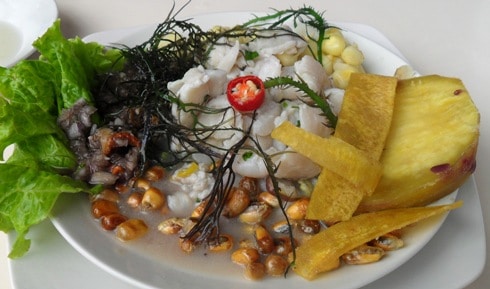
Ceviche at the Don Rulo restaurant in Trujillo (photo © Tony Dunnell)
Getting To Trujillo
Trujillo is on the Pan-American Highway (Panamericana), so getting there and away by land is a fairly straightforward process. Many of Peru’s best bus companies run between Trujillo and Lima (daily departures; 8 hours approx.), often heading further up along the coast to Chiclayo and Piura and sometimes as far as Máncora and the Peru-Ecuador border crossing near Tumbes.
An alternative option with multiple daily departures to various north coast destinations (as well as Cajamarca and Jaén) is the EMTRAFESA bus company. The main terminal in Trujillo is at Avenida Túpac Amaru in Huerta Grande.
If you want to head inland towards Chachapoyas, Moyobamba and Tarapoto, try to book your ticket at least a day in advance. Reliable companies along the route are limited (Movil Tours is perhaps the best option) and typically only have one daily departure at about 3:00 pm.
Trujillo’s Carlos Martínez de Pinillos International Airport (TRU) is located about 6.8 miles (11 km) from the city center. LAN and TACA, two of Peru’s major domestic airlines, have daily flights to and from Lima, with some connections to Chiclayo and Piura.
ENTERTAINMENT TIP: If looking for fun at night, or to watch sports during the day, or even a taste of home, visit the Wild Rover Hostels Chain for great food, sports and beer! Entrance to their bars is free even for non-guests
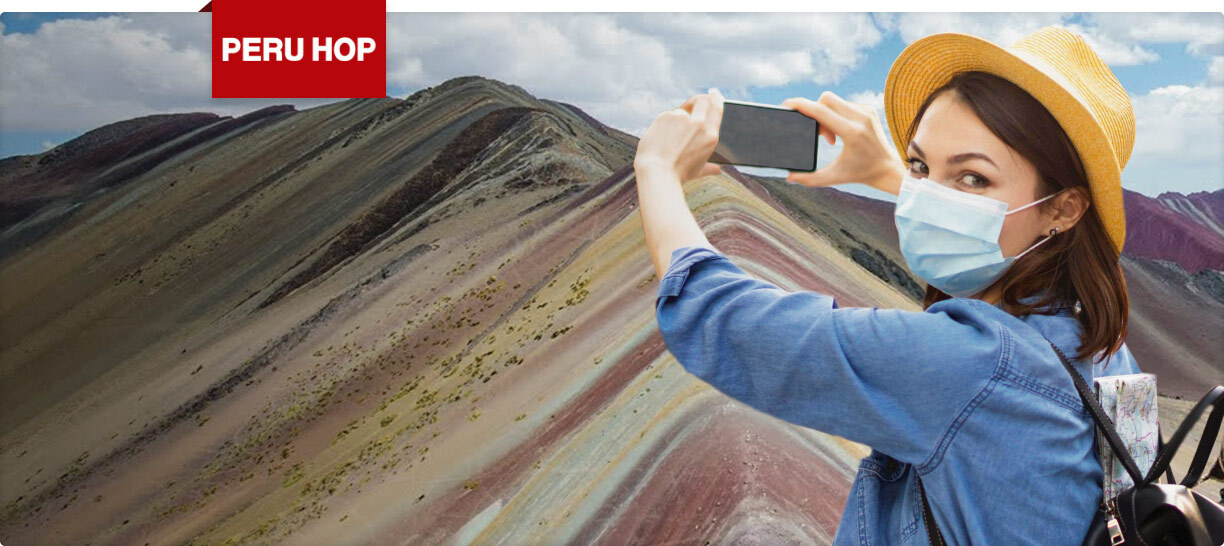


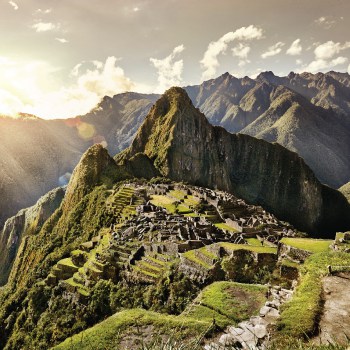






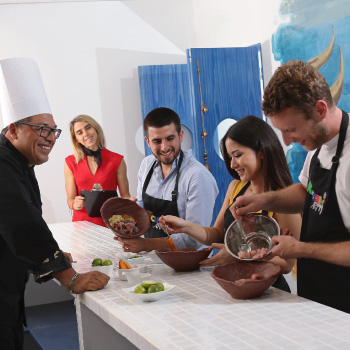
26 comments for “Trujillo, Peru’s City of Eternal Spring”